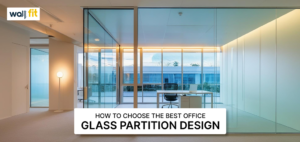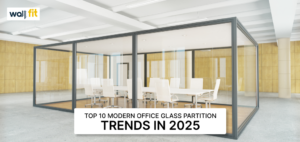
Most Inspiring Interior Design Office Themes for Workspaces
Home Top Inspiring Interior Design Office Themes for Modern Workspaces A well-designed office is essential for any business. It should

A well-designed workspace goes beyond aesthetics; it directly impacts productivity, collaboration, and employee well-being. With the shift toward hybrid work models and flexible office layouts, companies now prioritize modern office design that supports different work styles while maintaining a professional environment.
Whether your business requires open workstations, private offices, meeting areas, or relaxation zones, creating an efficient, comfortable, and tech-enabled workspace requires careful planning and smart design choices.
✔️ Increase productivity by optimizing space, minimizing distractions, and ensuring seamless workflows.
✔️ Reflects corporate branding with a stylish office interior design that enhances employee engagement and leaves a great impression on visitors.
✔️ Integrates smart technology for efficiency, making daily operations smoother and more connected.
✔️ Ensures adaptability, allowing businesses to scale up, reorganize layouts, or accommodate new work models effortlessly.
✔️ Enhances well-being, offering ergonomic furniture, good lighting, and breakout spaces for employee comfort.
From modular partitions and ergonomic furniture to smart lighting and sustainability features, let’s explore the top 10 interior design tips to create a future-proof, corporate-ready workspace.
A structured and efficient office layout maximizes space utilization and functionality, ensuring every area serves a purpose. Whether creating collaborative zones, private offices, or focus areas, a well-planned layout improves workflow and keeps employees comfortable. Integrating office design ideas like modular partitions, flexible seating, and optimized workstations enhances both efficiency and adaptability.
Suggestion: Sliding partitions or foldable walls allow quick transformations between open collaboration areas and private meeting rooms.
While open office spaces foster collaboration, employees also need quiet zones for focused work. Smart partitioning solutions create a balance between teamwork and individual concentration.
Glass partitions: Maintain an open feel while reducing noise and providing visual separation.
Acoustic paneling: Use soundproof materials in walls and ceilings to minimize distractions.
Private work pods: Create small, enclosed spaces for confidential calls or focused tasks.
Suggestion: Frosted or tinted glass partitions allow privacy while keeping the office bright and spacious.
Employees spend long hours at their desks, making ergonomic furniture essential for posture, comfort, and productivity. Poor seating and desk arrangements lead to fatigue and reduced efficiency.
Suggestion: Invest in AI-powered smart desks that adjust height, track posture, and remind employees to take breaks.
A tech-driven workspace enhances efficiency, automation, and security. Smart office design ideas make daily operations seamless while creating a connected work environment.
Suggestion: AI-powered occupancy sensors track workspace usage and optimize layouts in real time.
A well-designed office interior reinforces brand identity, professionalism, and work culture, making a lasting impression.
Suggestion: Dynamic LED branding panels allow companies to customize logos and displays in shared office spaces.
A noisy office environment reduces productivity, concentration, and overall efficiency. Employees need quiet areas to focus, while meetings require clear communication without external distractions. Implementing office design ideas such as acoustic partitions, soundproof panels, and noise-masking systems helps improve sound control, creating a comfortable and professional workspace.
Suggestion: Soundproof meeting pods can serve as dedicated spaces for confidential discussions without disturbing the entire office.
Good lighting and air quality significantly impact employee well-being, mood, and productivity. Studies show that natural light reduces eye strain and enhances mental clarity, while proper ventilation ensures a healthier work environment.
Suggestion: Smart skylights with automatic brightness adjustment optimize daylight use and reduce energy costs.
A workspace shouldn’t just be about work—employees need areas to unwind, recharge, and de-stress. Breakout spaces encourage informal interactions, creativity, and relaxation, ultimately boosting overall job satisfaction. Using an office 3D model helps visualize and plan these areas effectively, while incorporating smart office design ideas ensures a balanced and inspiring work environment.
Suggestion: Flexible breakout areas with modular furniture can double as collaboration hubs or solo relaxation spaces, depending on office needs.
Sustainable office interior design is not just about being eco-friendly—it also reduces operational costs, improves energy efficiency, and aligns with corporate ESG (Environmental, Social, and Governance) commitments. A sustainable modern office design creates a healthier, cost-effective workspace that enhances productivity and is more appealing to corporate clients.
Suggestion: Solar-powered workstations and recycled wood furniture enhance sustainability while adding a modern aesthetic to the workspace.
Businesses are constantly evolving, and a workspace should be flexible enough to grow and change along with the company. A well-planned modern office design should adapt easily to new teams, work models, and technology upgrades, avoiding expensive renovations. Implementing office design ideas like modular layouts, smart partitions, and multi-functional spaces can help create a future-proof workspace that meets the dynamic needs of any business.
Suggestion: Use VR-based office 3D models to test multiple layout configurations before making permanent changes, ensuring efficient space planning.
A well-designed workspace is more than just an office—it’s an environment that supports productivity, collaboration, and employee well-being. From ergonomic furniture and smart technology to sustainable materials and flexible layouts, the right office interior design ensures a positive and efficient work atmosphere.
With the right setup, businesses can create a modern office design that is adaptable, aesthetically pleasing, and built for long-term success. WallFit, the best glass partition firm, offers high-quality solutions for flexible, private, and professional office interiors. Their modular partition systems help businesses achieve functional, scalable, and visually appealing workspaces.

Home Top Inspiring Interior Design Office Themes for Modern Workspaces A well-designed office is essential for any business. It should

Home 10 Best Office Design Ideas for the Perfect Workspace A well-designed workspace goes beyond aesthetics; it directly impacts productivity,

Home Top 10 Office Glass Partition Trends in 2025: Revolutionizing Workspace Design Office glass partitions are now very popular in